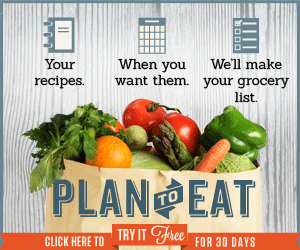Note: Thank you for all of your thoughts and prayers, last week was something I never expected to happen, but I am continuing to believe that the Lords plans are better than mine! If you couldn’t find Healthy 2days Wednesdays it’s because Anne hosted by herself, I just wasn’t up to it! I would like to thank Jenn, one of my contributing writers, for letting me publish her post today instead of last week.
Written by Jenn, Contributing Writer
Gardening is a great way to teach your children responsibility and patience. And it’s especially fun to watch their little eyes light up as they watch plants grow and see how hard work yields results! This is our first year of a “real” garden (as in more than four plants that produced maybe three tomatoes each), so I’m working hard to involve my two oldest children, ages six and three, in the process. Here are some ways you can garden with your kids!
Grow an Indoor Garden
For two and three year olds, it’s hard to wait a long time for plants to grow and bear fruit. For quicker results, put a few pea or bean seeds and a slightly moistened cotton ball in a plastic sandwich bag or see through disposable cup. Set it in a sunny space and watch them sprout! This will usually happen within a week. You can then transfer the seedlings into a container or garden plot. Herbs also grow well in windowsill pots where they have access to full sun. Make sure your containers have good drainage or you’ll end up with moldy plants.
Choose Age-Appropriate Garden Tools
Two and three year old children can handle a small garden trowel or cultivator to dig holes for planting (or just to dig for worms!). Preschoolers usually love to dig holes as well and can also help stake for vine plants such as beans and peas. School age children can help with raking and hoeing and of course kids of all ages can help with the weeding–as long as we remember to tell them which ones are the weeds!
Choose the Right Plants
Easy-to-grow veggies such as radishes, carrots and lettuce pretty much guarantee success without a lot of effort. And beans and peas have seeds that are big enough for little fingers to handle easily. In a climate with a shorter growing season, it might be helpful to choose seedlings (small plants) instead of seeds, especially for vegetables like peppers and tomatoes.
 |
| photo credit |
Keep a Calendar
Take note of the days of “maturity” for each plant–it’s usually written on the seed package or little tag that comes with the seedlings. Then create a calendar that will help your children better understand when they can expect to see a harvest!
Make Gardening into a Bible Lesson
One way to get God’s word into your children’s little hearts is to relate everyday occurrences to Bible passages and stories. You can talk about sowing and harvesting with your children and help them see how Scripture talks about “planting good seeds” and “bearing fruit”!
Some verses to use:
Isaiah 55:10
John 15:5
Matthew 13 (parable of the seeds and parable of the weeds, which are also found in Luke 8) Genesis 1:11
Jeremiah 17:7-8 …and many more!
How do your kids help you in the garden?

Join Jenn at The Purposeful Mom where she shares how she is learning to live with purpose in the spiritual, financial and practical areas of life. Her desire is that we would all “encourage one another and build each other up” 1 Thess. 5:11
You can also find Jenn on fb! Stop by and say “Hi!”













Great idea to tie scripture into gardening. My son loves to help me water the plants, and he’s been right there with me from the beginning of the process from seed to plant to bearing fruit. It’s exciting!
It’s so good for kids to learn where food really comes from, right?
Thank you for sharing! I have a bit of a “brown thumb” and can’t seem to keep any plant alive. But I’m inspired to try this with my kids.
So glad you enjoyed the post–I really don’t do well keeping things alive but it’s worked out so far this year–thankfully my husband is helping!